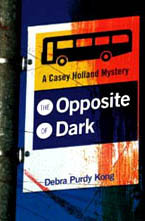This week on Mystery Mondays we welcome Debra Purdy Kong. I first came across Debra’s writing when I read Opposite of Dark. I loved the book and reached out to Debra on LinkedIn and was very excited to hear back from her. She’s an author who is generous with her time and her advice, which you’ll get some of below.
As you can imagine, I’m happy to host Debra on Mystery Mondays again.
Starting and Sustaining a Mystery Series by Debra Purdy Kong
Have you started to write a mystery series? With six published books in two series and more in the works, I’ve faced a number of challenges. Hopefully, these five tips will help you start and keep your series on track.
- Create your protagonist carefully. If you intend to write a lengthy series, do you want to start with a younger character and have her (or him) age a little more with every book, or do you want her to stay static like Agatha Christie’s Miss Marpole? Will your protagonist be complex enough to explore hidden and complex personality traits with each installment? The books in my Casey Holland series cover Casey’s life from ages thirty to forty, which becomes a unique and tumultuous time for her. Based on the feedback I’ve received, readers enjoy following the ups and downs in a protagonist’s personal life.
- Settings change. I write about Metro Vancouver, where the landscape changes every year. Sure, landmarks like Vancouver’s Stanley Park will always be there, but with infrastructure development (in my case, a new light rapid transit line close to my home in Port Moody), things can look quite different over time. The Port Moody I wrote about in Fatal Encryption eight years ago wasn’t as busy and complex as it is today. If real settings are a crucial part of your story, changes could have an impact on future plots.
- Pace yourself, and I mean this in two ways. From the get-go, decide how much time will pass between stories. If some of the key characters in your series are children, they’ll grow and change a fair bit from the first to the last book in your series, unless you intend to keep everything static. If you intend to show a passage of time, do you want your main characters to age a few weeks or months between books, or longer?
Secondly, consider pacing yourself as a writer. It’s a good strategy to focus on the first three novels in your series. Once you’re ready to submit your work to publishers, they’ll be happy if you have a long-term plan. Start thinking about the end game early in the process. How would you like to see the series end? How many books might it take to get there? Do you have the discipline and tenacity required to commit to a project that could take years to complete? Now that I’ve started the seventh book and have been working on this series for well over a decade, it’s something I struggle with.
- To avoid confusion, forgetfulness, and contradictions, keep detailed and accurate records about your series. I use an Excel spread sheet to provide an overview of the entire series. Column one lists the first installment, The Opposite of Dark. Beneath the title, I type the date and time of year the book takes place, Casey’s age, and that of her young ward, Summer. I briefly state the book’s plot and theme. I also note details about the murder. Trust me, it’s far too easy to forget these things over time.
Because my plots blend Casey’s workplace (Mainland Public Transit) with her personal life, I keep a record of every MPT employee mentioned in each book on a second Excel sheet. I like to bring back secondary characters now and then, so it’s important to track when employees appear in the series.
For each book, I maintain a Word document that contains detailed profiles of all main characters, plus those who are only featured in a specific book. The document is copied into every folder I create for each book. New characters are added, along with fresh aspects about ongoing characters. Experiment with recordkeeping ways that work for you.
- If you’re growing weary of the series, let it go, at least for a while. An author’s best work comes from caring about their characters and plots, and staying solely with the same characters year after year can be tiring. Unless you have deadlines to meet, it’s okay to take a break. I’ve found that launching new writing projects helps stimulate ideas for my Casey series. So, go ahead and stretch your creative wings when you need to. You’ll be surprised at all the good things that can happen.
WHO IS DEBRA?
 Author of six full-length mysteries, a novella, and over fifty short stories, Debra has won numerous awards for her short fiction. Drawing on her work experiences in security, she’s created transit security cop, Casey Holland in The Opposite of Dark, and campus security cop, Evan Dunstan in her first novella Dead Man Floating When she’s not writing, she’s employed part time at Simon Fraser University and is a facilitator for the Creative Writing program with Port Moody Parks & Recreation. More information about Debra can be found at www.debrapurdykong.com
Author of six full-length mysteries, a novella, and over fifty short stories, Debra has won numerous awards for her short fiction. Drawing on her work experiences in security, she’s created transit security cop, Casey Holland in The Opposite of Dark, and campus security cop, Evan Dunstan in her first novella Dead Man Floating When she’s not writing, she’s employed part time at Simon Fraser University and is a facilitator for the Creative Writing program with Port Moody Parks & Recreation. More information about Debra can be found at www.debrapurdykong.com
Just in case you’re as excited to read Debra’s books as I was, here are the links:
 THE OPPOSITE OF DARK: myBook.to/TheOppositeofDark
THE OPPOSITE OF DARK: myBook.to/TheOppositeofDark
Kobo: https://store.kobobooks.com/en-ca/ebook/the-opposite-of-dark-2

FATAL ENCRYPTION: myBook.to/FatalEncryption
Kobo: http://tinyurl.com/z5sagyl
 DEAD MAN FLOATING: myBook.to/DEADMANFLOATING
DEAD MAN FLOATING: myBook.to/DEADMANFLOATING
Kobo: https://store.kobobooks.com/en-CA/ebook/dead-man-floating


Some great points here, Debra, especially about setting. Even fictional places should have change. As you say, nothing and no one stays the same over time, and we owe it to our stories to remember that.
LikeLiked by 2 people
Thanks for stopping by, Judy!
LikeLike
Hi Judy, thank you! Yes, setting changes can muddle things up! If I feel it’s necessary, I put a caveat in the Author’s Notes, so readers won’t become confused by the mention of something that no longer exists!
LikeLike
I really enjoyed this post, Debra. I also write a mystery series (for Camel Press). The fourth book is due out January 15, 2017, and the fifth’s pub date is June 1. I’m halfway finished with #5, and have one more under contract. After that, I’m not sure. I might try to keep the series going, but I have another character knocking around in my head. Time will tell. Great advice on keeping such records about the previous books and characters. I’m a very disorganized person and routinely find myself searching through previous manuscripts or books to confirm names of characters, or facts pertinent from one novel to the next, etc. Your way sounds MUCH better and wiser! Hey, how much would you charge to put my “house” in order? 🙂
Kristina, thanks for hosting Debra–very good and informative post!
–Michael
LikeLiked by 1 person
Hi Michael, thanks for your thoughts. I keep a spreadsheet with the details. That saves me from searching back through books. Always great to have Debra here, too.
LikeLiked by 2 people
Thank you for inviting me back, Kristina. It’s always a pleasure to be a guest on your blog!
LikeLiked by 1 person
Hi Michael, thank you for your comments, and I’m glad that the tips help. I know it seems daunting, but you’d be surprised how much you can accomplish in just one hour of sitting down and noting the specifics of each book. Sometimes, just jotting things down on a piece of paper can help. Baby steps, my friend. A little each day. Congratulations on getting as far as you have in your series with book five!
LikeLiked by 1 person
A great article full of valuable advice, Debra! I have decided to keep my character, Amanda, the same age throughout the series. (Like Nancy Drew) I´ll see how that works. I will take your suggestion of a spreadsheet to keep myself organized. I need help with that!
LikeLiked by 1 person
Hi Darlene, and thank you for your comments. I can sure see the advantage in keeping things the same. It does save you some logistical headaches, and there are plenty of mystery fans who like keeping things the same. It provides comfort in knowing what they’re getting when they crack open that new book! And you’re right, a spreadsheet will still help with your plot points and murder motives, etc.
LikeLiked by 2 people
The main reason for me keeping her the same age is I like writing for middle readers or tweens, if she got older, I would be into YA which is a different thing altogether. I just have to be careful not to get too predictable. Once in awhile, Amanda has to act out of character, which tweens are known to do!! I wish you continued success, Debra.
LikeLiked by 1 person
Thank you, Darlene. And the same to you!!
LikeLike
Thank you, Kristina and Debra, for his useful post – timely for me, as I’m working on the first book of a children’s series. I like the idea of keeping things static.
LikeLiked by 1 person
Hi Annabelle, Congrats on working on a new series. I hope that’s fun for you!
LikeLiked by 1 person
Hi, Annabelle, yes, there are benefits to keeping things static. It’s an important thing to decide while you’re working on that first book. Best of luck in your children’s series!
LikeLiked by 1 person
Thanks, Kristina. Very helpful remarks! I have written a trilogy and am now writing another series. When I wrote the trilogy (my first novels), I actually started with the second book–it just happened that way–then Book 1 and finally Book 3. I had quite a few timing problems this way, not just with the age of the characters but with the time in general. A spreadsheet would definitely have helped! I read your novel, Descent. Great book–made me want to go skiing again!
LikeLiked by 1 person
Hi Christa, It’s very interesting to hear you started on book 2. I did the same. I wrote Avalanche first. Then my agent suggested it should be third, so I went back and rewrote all three novels to make this work. I think the series is better for it. Thanks for visiting today and thanks for reading Descent. I’m glad you liked it.
LikeLike
Great blog, Debra. Some very interesting points. I’ve read a couple of your books and you really do have a talent for bringing settings to life.
LikeLiked by 1 person
Thank you, Sandra. Your feedback is much appreciated!! And I’m very happy so see that you’re still writing. It seems like a long time ago that we were critiquing online!
LikeLike
Thanks for the solid advice, Debra. Series writing certainly does have its challenges and memory only goes so far. Thanks, Kristina for featuring Debra’s work and wisdom.
LikeLiked by 1 person
Hi Jo-anne, Always nice to see you hear. You write a pretty awesome series yourself! I’ve read 3 of THE GIFT Series and loved them all. https://www.amazon.ca/Gift-Revelation-J-P-McLean/dp/0993600492/ref=sr_1_5?ie=UTF8&qid=1476731280&sr=8-5&keywords=j.p.+mclean
LikeLiked by 1 person
Ah, I need to start reading this series!
LikeLike
Thank you!
LikeLike
You’re very welcome and thanks for commenting! Yes, I’ve talked with a few authors over the years who said that if they had thought through some key aspects at the beginning they would have done things differently. Their experiences taught me a lot.
LikeLiked by 2 people
It’s wonderful how many authors are willing to share their experiences with the rest of us out here. Such a great community.
LikeLike
It is, and I’m very happy to be part of it 🙂
LikeLike
This was super information since this is my first series. I am revising book 2, and when I’m in between revisions, I’m working on book 3. I have already found out how valuable it is to have information written down in an orderly manner.
Thanks for your good suggestions.
LikeLiked by 1 person
Thank you so much for commenting, and I’m glad the suggestions were helpful. So much of writing is a learning as we go situatain, but it sounds like you’re well on your way. Best of luck to you!!
LikeLike